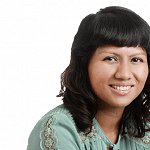Playwright and director Najib Soiman's latest production, Ma'ma Yong: About Nothing Much To Do, is about revival.
In form as well as in name, it references the traditional Malay dance-drama art form, mak yong, which originated from Kelantan.
Najib says: "Many people don't know about mak yong, it is a dying art form."
Ma'ma Yong - whose full title references William Shakespeare's 1598 comedy Much Ado About Nothing, about two courting couples - is essentially a play-within-a-play, transposed to a modern setting.
Main character Fatimah, a literature teacher, is admitted to a mental asylum after being possessed by the spirit of a mak yong performer.

There, she as Ma'ma Yong helps heal some of the patients, prompting the asylum's staff to assist the patients to put on a play, Much Ado About Nothing, in order to facilitate further healing.
Najib presented the same production on a smaller scale in 2008. This new production will be held at the Esplanade from Oct 22 to 24.
Elements of mak yong that will be shown include the "menghadap rebab", where the actors pay respect to a stringed lute known as the rebab. This ritual traditionally opens a mak yong performance.
Another ritual is the "main petri", a spiritual cleansing ritual where a performer known as Pak Yong helps heal patients who suffer from afflictions such as depression or a weak spirit.
-
BOOK IT
-
MA'MA YONG: ABOUT NOTHING MUCH TO DO
WHERE: Esplanade Theatre StudioWHEN: Oct 22 to 24,3and 8pm (Thursday and Friday),8pm (Saturday)
ADMISSION: $28 (go to www.sistic.com.sg or call 6348-5555 )
The spiritual element of mak yong performances led to its ban in Kelantan in 1991 because it was deemed to be un-Islamic.
Actress Aidli Mosbit, 41, who plays Fatimah and is reprising the role from the 2008 show, says: "Personally for us, we don't see it so much as a contradiction to what we are as Muslims. This is part of our culture, this is tradition."
Najib adds: "Our first few religions as Malays were Hinduism and animism before the coming of Islam. We need to accept this, we should not deny this. Culture is culture, religion is religion."
The 38-year-old, who grew up learning the Malay traditional arts, has incorporated multiple art forms into Ma'ma Yong, including dikir barat (a form of collective singing accompanied by percussion instruments and coordinated hand movements), wayang kulit (shadow puppetry) and joget (Malay traditional dance).
He says: "For me, it's more about sharing these art forms. Usually, they are done separately, but now we're bringing them into one theatre performance."
He is also employing another dying format for Ma'ma Yong - theatre rakyat or folk theatre, where actors are allowed to break character and "sakat" or tease one another as long as they continue the story.
Aptly, the multi-faceted production has a diverse cast made up of practitioners of different races, backgrounds and ages.
The youngest is Singaporean actress Selma Alkaff, 19, and the oldest is British-Jamaican actress Sharon Frese, 51. They both play multiple roles.
While the play is predominantly in Malay with English surtitles, some parts will be performed in English, Tamil, Mandarin and Jamaican, making it what Najib calls "a local product".
Actor and puppeteer Bright Ong, a Malaysian-born Singapore permanent resident, struggled a bit with the formal Malay used in Ma'ma Yong.
Says the 27-year-old, who is playing the villain Don John, as well as puppeteering a man-sized tron which represents one of the guards in the play: "I'm still dealing with the language. I'm a budak Johor (Johor kid), so my Malay is very street. But it's getting better."
Another unique aspect of the production is that the five musicians are also part of the cast.
Headed by music director Fadhli Ramlee, they will perform double duty playing live music while also acting as workers in the mental asylum.
"Usually the musicians are located at the back of the stage or in the orchestra pit, but now we'll be in the middle of the stage," says Fadhli, 31.
To suit the old-meets-new energy of the production, the musicians will play both traditional instruments, such as the rebab, as well as modern ones such as drum pads and guitars.
Ong says he is enjoying the process a lot, adding that "there are not many avenues for a Chinese boy to do these things".
"There have been a lot of cultural exchanges. I really enjoy it. That is what's really beautiful about this process - we are creating theatre instead of just putting on a show."

